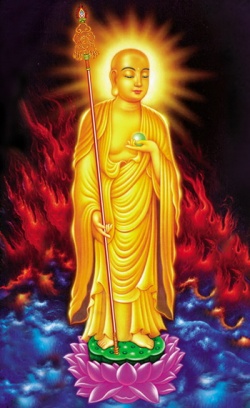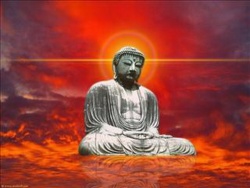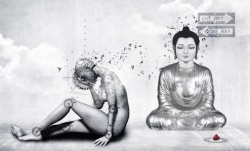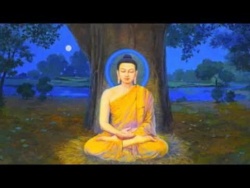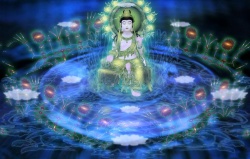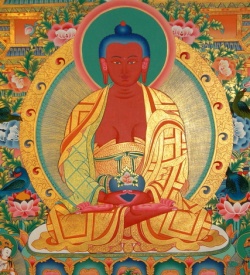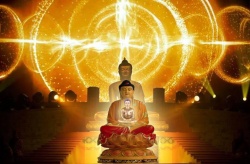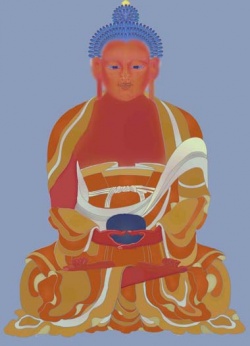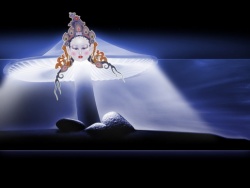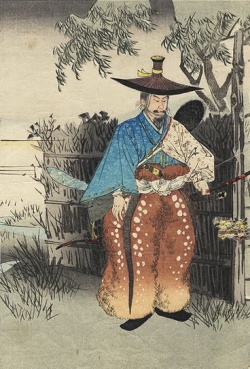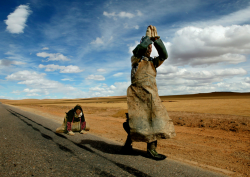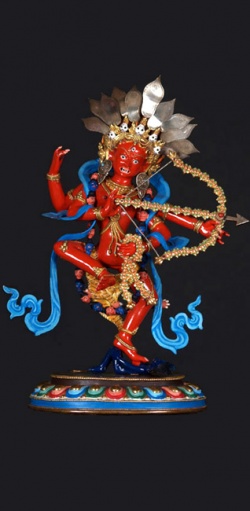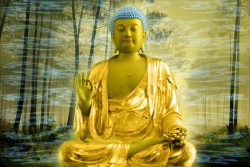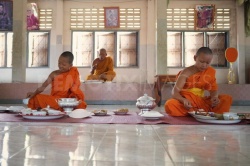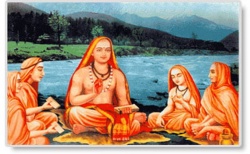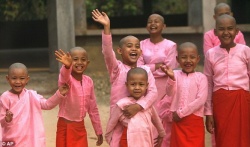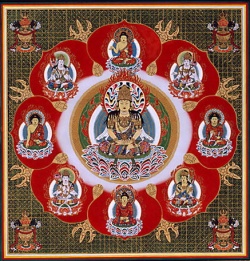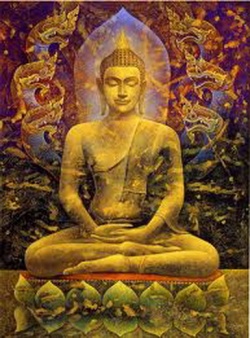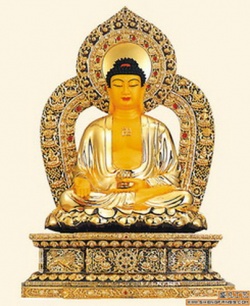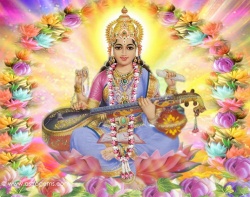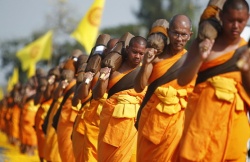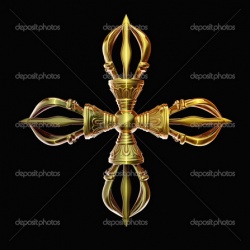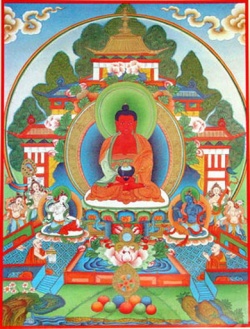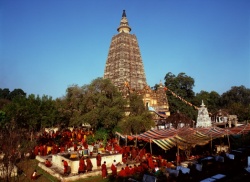Wrathful Guardians of Buddhism - Aesthetics and Mythology
by Nitin Kumar
An enigmatic aspect of Buddhist iconography is the presence of wrathful, terrifying forms.
Though these awesome, Hair-raising images seem contradictory to Buddhist ideals, they are not personifications of Evil or demonic forces. Rather they symbolize the violence that is a fundamental reality of the cosmos in general, and of the human Mind in particular.
In addition to destroying the passions of the Mind, the purpose of Gods is to protect the faithful.
The wrathful Deities, who symbolize the tremendous effort it takes to vanquish Evil, especially perform this function. In the arena of Buddhist Art, the two main classes of objects that constitute our Interest are the small bronze sculptures, kept on altars, and the scroll-paintings, better known as thangkas.
Both are intended as temporary dwellings for the Spiritual, beings into which Buddhism projects its analysis of the nature of the World.
They are thus not aesthetic objects but roosting places, actual dwellings for the energies projected into them with the aid of Mantras, which are often inscribed on them; the Power of those energies can then be canalized towards the Buddhist goal.
Not surprisingly thus, these wrathful Deities, though benevolent, are represented in visual arts as hideous and ferocious in order to instil terror in Evil Spirits which threaten the Dharma.
According to the norms of canonical iconography, these wrathful Protective deities are described as figures possessing stout bodies, short but thick and strong limbs and many of them have several heads and a great number of hands and feet.
The color of their faces and bodies and faces is frequently compared with the characteristic hue of clouds, precious stones, etc.
Thus we often read in the Sadhanas (Canonical texts) that one or the other wrathful Deity is black “like the cloud which appears at the end of a Kalpa (aeon)”, blue “like an emerald” or white “like a mountain of crystal”.
The yellow color is compared to that of pure gold, and the red color of some of them is supposed to be “like the hue produced when the sun rises and its rays strike a huge mountain of coral”.
These Sadhanas often mention that the Body of a ferocious protective Deity is smeared with ashes taken from a funeral pyre and with sesame oil or that their skin is covered with grease-stains, blood spots and shining specks of human fat.
Their faces possess a typical wrathful expression: the mouth is contorted to an angry smile, from its corners protrude long fangs – often said to be of copper or iron -, or the upper teeth gnaw the lower lip.
A “mist of illnesses” comes forth from the mouth and a terrific storm is supposed to be blowing from the nostrils of the flat nose.
The protruding, bloodshot Eyes have an angry and staring expression and usually a third Eye is visible in the middle of the forehead.
The most important category of these Deities is the group of eight, known as Dharmapalas (Sans. Dharam: Religion; Pala: protector), known in Tibetan as Drag-ched.
The Dharmapalas, or defenders of Buddhism, are divinities with the rank of Bodhisattva, and are supposed to wage War without any mercy against the demons and enemies of Buddhism.
These eight Deities are:
Yama
Mahakala
Yamantaka
Kubera
Hayagriva
Palden Lhamo
Tshangs pa
Begtse
Yama: The God of Death
According to the popular version of the mythological origins of Yama, a holy man was told that if he spent fifty years living in deep Meditation in a cave, he would reach Enlightenment.
On the night of the twenty-ninth day of the eleventh month of the forty-ninth year, two robbers entered his cave with a stolen bull whose head they proceeded to cut off.
When they realized that the hermit had witnessed their act, they decided to kill him.
He begged them to spare his Life, explaining that in a few minutes he would reach Enlightenment and that all his efforts would be lost if they killed him before the expiration of the fifty years.
The thieves ignored his request and cut off his head.
Immediately, he assumed the ferocious Form of Yama and put the bull’s head on his own headless Body.
He then killed the two robbers and drank their blood from cups made from their skulls.
In his fury, he threatened to destroy the entire population of Tibet.
The Tibetan people appealed to the Deity Manjushri (the Bodhisattva of Wisdom), to protect them from Yama.
Manjushri then assumed the Form of Yamantaka (conqueror of Death), defeated Yama, and turned him into a protector of Buddhism, in order to save the people.
In visual imagery he is often shown accompanied by his consort, Chamundi, who offers Yama a skull bowl full of demon-blood elixir.
He is represented nude, wearing a garland of severed human heads.
Dark blue in color he has a buffalo’s head, and is shown in a dynamic position on this animal.
Mahakala: The Great Black One
The legendary history of Mahakala was written by Khedrup Khyungpopa, founder of the Shangpa Kagyu tradition, in the eleventh century.
He says that the reason for the special powers and effectiveness of Mahakala goes back to Avalokiteshvara’s vow to remain in the mortal World and not reach Buddhahood until all Sentient beings were Enlightened.
After helping hundreds of thousands of people for countless years to reach Enlightenment, Avalokiteshvara saw no decrease in Suffering, but rather an increase in Defilements.
He then became discouraged.
As soon as he had that Thought, his head immediately split into a thousand pieces.
Amitabha, one of the five transcendent Buddhas, put the pieces back together and made eleven heads, telling Avalokiteshvara to make the same promise again but to keep it better.
Accordingly out of Avalokiteshvara’s eleven faces, ten are peaceful, but one is wrathful, representing Mahakala.
Avalokiteshvara, saddened, fell Unconscious for seven days, after which he Thought that the World’s Suffering souls needed results in a hurry without excessive effort.
He then wished to turn himself into a wrathful Deity in order to defeat more rapidly and effectively the obstacles to the Happiness of others.
With this Thought the letter HUM in dark blue color came out of his Heart.
That Hum became Mahakala.
It is not without significance that in the Mantra ‘Om Mani Padme Hum’, the syllable Hum invokes energetic powers.
The birth of Mahakala was followed by an earthquake and with one Voice the Buddhas in the Heaven declared that he would have the Power to grant all wishes if the wishes were honest and good.
Mahakala was the personal tutelary Deity for the Mongol ruler Kublai Khan.
His terrifying imagery ultimately derives from the angry Form of the Hindu God Shiva, known as Bhairava.
In Tibetan iconography he typically has one head with three bulging Eyes.
His eyebrows are like small flames, and his beard is made of hook-like shapes. He can have two to six arms.
The essential nature of Mahakala in the Tibetan pantheon can be gauged from the fact that he is worshipped as the Protector of the tent.
Because of the nomadic nature of the Tibetan people, much of their Life is spent in arduous and hazardous travel, complicated by the generally hostile environment they live in.
During their sojourns, they use the Tent as a temporary abode, making it a very important part of their lives.
He is also unquestionably the most vital Dharmapala, since every Monastery, no matter what the order, has a shrine devoted to this Deity.
Yamantaka: The Conqueror of Death
Yamantaka, the ferocious emanation of Manjushri (Bodhisattva of Wisdom), is the most complicated and terrible of all the wrathful Buddhist divinities.
Under this from he conquered the demon king of Death, Yama, who was depopulating Tibet in his insatiable thirst for victims.
According to this myth, in his paroxysm of Insight, Manjushri traveled all the way to the underworld to seek out Yama, the God of Death, who dwells with all his minions in the sealed up iron cities of Hell.
Yama appears in Indian mythology with the head of a water buffalo.
To tame Yama, Manjushri adopted the same Form, adding to it eight other faces and a multiple array of arms, each holding fearful and deadly Weapons.
He further sprouted a corresponding number of legs, and surrounded himself with a vast host of terrifying beings.
To confront Death, he thus manifested the Form of Death itself, magnified to infinity.
Death (Yama) saw himself endlessly mirrored back to himself, infinitely outnumbered by himself.
Death was literally scared to Death.
Thus the yogi who meditates through the imagery of Yamantaka intends and hopes to develop a sense of identity strong enough to face down Death, and the fear that attends upon it.
Each head, each limb, each attribute, Symbol and ornament of Yamantaka expresses the total mobilization of the faculties of Enlightenment needed for this ultimate confrontation.
Both Yama and Yamantaka are represented with bull’s heads, but Yama always has an ornament, shaped like a Wheel on his breast, which is his distinctive mark.
Kubera or Vaisravana, the God of Wealth
According to Hindu mythology, Kubera was the son of a sage called ‘Visravas’, hence his patronymic Vaisravana.
He is said to have performed austerities for a thousand years, in reward for which Brahma, the Creator, gave him immortality and made him God of Wealth, guardian of all the treasures of the Earth, which he was to give out to whom they were destined.
Kubera’s abode was said to be Mt Kailash; but when Brahma appointed him God of Riches, he gave him Lanka (Ceylon) as his capital, and presented him, according to the Mahabharata, with the car pushpaka, which was of immense size and ‘moved at the owner’s will at marvellous speed’.
Kubera is also worshipped by the Buddhists, where he is looked upon as the guardian of the North.
His characteristic Symbol is the mongoose, often shown vomiting jewels.
In the Buddhist pantheon he is also known as Jambhala, probably from the jambhara (lemon) he carries in his hand.
He is always represented corpulent and covered with jewels.
His right foot is generally pendant and supported by a Lotus-flower on which is a Conch shell.
Hayagriva: The Horse-necked one
Hayagriva is worshipped in Tibet principally by Horse-dealers because he is believed to frighten away demons by neighing like a Horse.
When invoked, he is said to announce his coming by neighing, which accounts for the presence of a Horse’s head, his distinctive mark, in his head-dress.
The Horse’s head neighs loudly, and the Sound is said to pierce all false Appearances of substantiality, revealing the shining reality of freedom.
His Mantra contains the following verse:
"I request that you protect all horses. Increase the number of mares.
For from the mother of the Horse many supreme horses will be born.
Please disperse the obstacles on the Path and reveal the right direction."
Hayagriva is a wrathful manifestation of Avalokiteshvara. There are believed to be 108 forms of Hayagriva.
His special ability is to cure diseases, especially skin diseases even as serious as leprosy, which is said to be caused by the Nagas (malignant water Spirits with serpent bodies).
In his simplest Form he is depicted with one face, two arms and two legs.
Everything about him is terrific-his scowling face with three glaring Eyes, his roaring mouth with protruding fangs, his pose of warrior’s aggressiveness, his broad belly bulging with inner energy, his sword raised threateningly in his right hand, his left hand raised in a threatening gesture and his snake ornaments.
His beautiful, terrific aspect expresses Compassion’s fierce determination to help us overcome inner egotistic addictions and outer obstructions.
Palden Lhamo: The Goddess
Palden Lhamo is the only female among the eight great dharmapalas.
She is a protectress of Buddhist governments everywhere, including the Dalai Lamas and their government in Lhasa.
She was also a protectress of imperial China from the Yuan dynasty in the thirteenth century to the end of the Qing dynasty in the twentieth century.
In India, Palden Lhamo is also known as Shri Devi.
She is considered a wrathful manifestation of Saraswati, the Goddess of learning, eloquent speech, and music.
Another of her manifestation is Chamundi, the consort of Yama.
Being the only Goddess defender of the Dharma, she is said to have been armed by the Gods themselves.
Hevajra gave her two dice to determine the Life of men, Brahma gave her a fan of Peacock’s feathers, and from Vishnu she received two luminous objects, of which she wears one in her headdress., while the other hangs over her navel.
Kubera, the God of Wealth, gave her a lion, which she wears in her right ear; and Nanda, the serpent God, gave her a serpent, which hangs from her left ear.
From Vajrapani she received a hammer.
Other Gods gave her a mule, whose covering is the skin of a Yaksha or demon, and the reins are venomous serpents.
She is always shown seated sideways on this mule.
In addition, Lhamo has an extensive retinue of fierce supporters whose portrayal has resulted in some of the most complex, densely composed paintings in the whole of Tibetan Art.
These grotesque depictions of Lhamo are visions of a kind of compassionate activity, as her story makes clear:
She is said to have been married to a bloodthirsty warring king who refused all her entreaties to stop his wanton killing.
She finally issued an ultimatum: if he wouldn’t stop the killing, she would personally slay their child so the king would experience for himself the pain that his warring caused to others.
He did not stop, she carried out her threat, and his loss finally did bring him to a halt.
She is often depicted carrying her dead son’s Body with her on her mule, showing that she will stop at nothing to achieve peace.
Tshangs Pa or ‘White Brahma’
Brahma, one of the most important Gods of the Hindu pantheon, occupies only a secondary position in Tibetan Buddhism.
His Tibetan name is Tshangs pa, and under this term, the ordinary four-headed and two handed Form of Brahma is understood, represented in accordance with Indian iconographic concepts.
More frequently, however, one encounters in Tibetan religious Art the representation of a white, one headed and two-handed God named Tshangs pa dkar po, “the white Tshangs pa”.
According to the Sadhanas, this God too is identified with Brahma.
He is represented seated on a white Horse, brandishing a sword, and sometimes carrying a banner.
He is a warrior God, but not so ferocious in aspect.
Behind his crown is a turban, in which there is a Conch-shell, and he wears flowing garments and long sleeves.
Though the legend behind his origin does not detail his association with Brahma, it nevertheless is an interesting one:
Long time in the past, a couple gave birth to a son whom they named Tshangpa karpo.
He grew up endowed with full manly attributes, and rode across the cosmos on a super-Horse of golden velocity.
In daytime he rode across the sky and at night he descended to the ground.
At one time he went up into Heaven. There he seduced a Goddess girl named Dhersang, and stole the God’s wish-fulfilling jewel.
But he was stopped by the guardians of Heaven who grabbed him by his tongue and flung him to the ground, took back the jewel in his hand, and also took his Life-Heart.
He was also betrothed to the above Goddess girl.
Dissatisfied by his ‘defeat’, he continued making cosmic journeys on his unique mount.
A moment came when he started killing all males he came across and forcibly fornicated with all the females he saw.
One day he came across the Goddess Ekazati.
Intending to disturb her, he started taking liberties.
The Goddess became angry and struck him with her turquoise ornamented silk breech-cloth.
It hit him on his thigh and he became lame.
Her striking him thus is fraught with symbolic interpretations since the myth further states that immediately after he was transformed into a protective Deity.
Her retaliation was not an assault in a physical sense.
It was an attack on the negative part of his psyche, which was persuaded to transform itself into unambiguous and affirmative action.
Thus his immense energies were channelised into constructive and worthy action, namely guarding the Dharma and protection of the faithful.
In a historical sense this represents the integration of the uncivilized shamans of the ancient Bon Religion of Tibet into the realm of the Dharma, by the great master Padmasambhava.
Begtse: The God of War
This ferocious warrior, in armour and wearing Mongolian boots appeared in the Tibetan Buddhist pantheon only in the second half of the 16th century, the last one to join the group of the Eight Dharma Protectors.
According to legend, Begtse appeared before the Dalai Lama, who was heading an army of Animals.
The Dalai Lama had been summoned from Tibet by the powerful Mongol King Altan Khan to convert the Mongols to Buddhism.
Finding himself thus confronted, the Dalai Lama transformed himself into the four-armed Avalokiteshvara, the Bodhisattva of Compassion, with two of his hands at his breast in the ‘prayer’ Mudra.
The footsteps of his Horse left the marks of Avalokiteshvara’s Mantra, ‘Om mani padme hum!’ on the sands.
this Miracle, Begtse became convinced of the Dharma’s superiority and submitted himself, converting to Buddhism.
This terrible Deity is thus said to symbolize the Conversion of the Mongols to Buddhism.
He is represented with all the ornaments of the Dharampala, brandishing a sword in his right hand, the handle of which is in the shape of a scorpion.
His left hand holds the orange Heart of an enemy near his mouth, clutching at the same time a bow and an arrow.
He tramples upon the corpse of a man with his left foot and the carcass of a Horse with his right foot.
His three Eyes are full of fury directed at the enemies of the Dharma.
The conception and visualization of these ferocious forms represents a landmark in the development of Esoteric human Thought.
A product of fertile and imaginative minds, they represent the pinnacle of creative human endeavor.
Indeed in man’s eternal search to understand the Mysterious force that is nature, these ideas represent a significant step forward.
